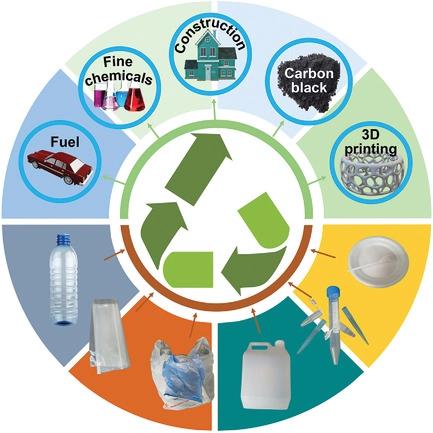当前位置:
X-MOL 学术
›
Adv. Mater.
›
论文详情
Our official English website, www.x-mol.net, welcomes your
feedback! (Note: you will need to create a separate account there.)
Upcycling to Sustainably Reuse Plastics
Advanced Materials ( IF 27.4 ) Pub Date : 2021-07-08 , DOI: 10.1002/adma.202100843 Xin Zhao 1 , Bhanupriya Boruah 1, 2 , Kek Foo Chin 1 , Miloš Đokić 1 , Jayant M Modak 2 , Han Sen Soo 1, 3
Advanced Materials ( IF 27.4 ) Pub Date : 2021-07-08 , DOI: 10.1002/adma.202100843 Xin Zhao 1 , Bhanupriya Boruah 1, 2 , Kek Foo Chin 1 , Miloš Đokić 1 , Jayant M Modak 2 , Han Sen Soo 1, 3
Affiliation

|
Plastics are now indispensable in daily lives. However, the pollution from plastics is also increasingly becoming a serious environmental issue. Recent years have seen more sustainable approaches and technologies, commonly known as upcycling, to transform plastics into value-added materials and chemical feedstocks. In this review, the latest research on upcycling is presented, with a greater focus on the use of renewable energy as well as the more selective methods to repurpose synthetic polymers. First, thermal upcycling approaches are briefly introduced, including the redeployment of plastics for construction uses, 3D printing precursors, and lightweight materials. Then, some of the latest novel strategies to deconstruct condensation polymers to monomers for repolymerization or introduce vulnerable linkers to make the plastics more degradable are discussed. Subsequently, the review will explore the breakthroughs in plastics upcycling by heterogeneous and homogeneous photocatalysis, as well as electrocatalysis, which transform plastics into more versatile fine chemicals and materials while simultaneously mitigating global climate change. In addition, some of the biotechnological advances in the discovery and engineering of microbes that can decompose plastics are also presented. Finally, the current challenges and outlook for future plastics upcycling are discussed to stimulate global cooperation in this field.
中文翻译:

升级循环以可持续地重复使用塑料
塑料现在在日常生活中是不可或缺的。然而,塑料造成的污染也日益成为一个严重的环境问题。近年来,人们看到了更可持续的方法和技术,通常称为升级再造,将塑料转化为增值材料和化学原料。在这篇综述中,介绍了关于升级再造的最新研究,更加关注可再生能源的使用以及重新利用合成聚合物的更具选择性的方法。首先,简要介绍热升级循环方法,包括重新部署塑料用于建筑用途、3D 打印前体和轻质材料。然后,讨论了一些将缩合聚合物解构为单体以进行再聚合或引入易受攻击的接头以使塑料更可降解的一些最新策略。随后,该综述将探讨通过非均相和均相光催化以及电催化在塑料升级循环方面的突破,将塑料转化为更多用途的精细化学品和材料,同时缓解全球气候变化。此外,还介绍了在发现和改造可分解塑料的微生物方面的一些生物技术进展。最后,讨论了当前的挑战和未来塑料升级循环的前景,以促进该领域的全球合作。该审查将探讨通过非均相和均相光催化以及电催化在塑料升级循环方面的突破,将塑料转化为更多用途的精细化学品和材料,同时缓解全球气候变化。此外,还介绍了在发现和改造可分解塑料的微生物方面的一些生物技术进展。最后,讨论了当前的挑战和未来塑料升级循环的前景,以促进该领域的全球合作。该审查将探讨通过非均相和均相光催化以及电催化在塑料升级循环方面的突破,将塑料转化为更多用途的精细化学品和材料,同时缓解全球气候变化。此外,还介绍了在发现和改造可分解塑料的微生物方面的一些生物技术进展。最后,讨论了当前的挑战和未来塑料升级循环的前景,以促进该领域的全球合作。还介绍了在发现和设计可分解塑料的微生物方面的一些生物技术进展。最后,讨论了当前的挑战和未来塑料升级循环的前景,以促进该领域的全球合作。还介绍了在发现和设计可分解塑料的微生物方面的一些生物技术进展。最后,讨论了当前的挑战和未来塑料升级循环的前景,以促进该领域的全球合作。
更新日期:2021-07-08
中文翻译:

升级循环以可持续地重复使用塑料
塑料现在在日常生活中是不可或缺的。然而,塑料造成的污染也日益成为一个严重的环境问题。近年来,人们看到了更可持续的方法和技术,通常称为升级再造,将塑料转化为增值材料和化学原料。在这篇综述中,介绍了关于升级再造的最新研究,更加关注可再生能源的使用以及重新利用合成聚合物的更具选择性的方法。首先,简要介绍热升级循环方法,包括重新部署塑料用于建筑用途、3D 打印前体和轻质材料。然后,讨论了一些将缩合聚合物解构为单体以进行再聚合或引入易受攻击的接头以使塑料更可降解的一些最新策略。随后,该综述将探讨通过非均相和均相光催化以及电催化在塑料升级循环方面的突破,将塑料转化为更多用途的精细化学品和材料,同时缓解全球气候变化。此外,还介绍了在发现和改造可分解塑料的微生物方面的一些生物技术进展。最后,讨论了当前的挑战和未来塑料升级循环的前景,以促进该领域的全球合作。该审查将探讨通过非均相和均相光催化以及电催化在塑料升级循环方面的突破,将塑料转化为更多用途的精细化学品和材料,同时缓解全球气候变化。此外,还介绍了在发现和改造可分解塑料的微生物方面的一些生物技术进展。最后,讨论了当前的挑战和未来塑料升级循环的前景,以促进该领域的全球合作。该审查将探讨通过非均相和均相光催化以及电催化在塑料升级循环方面的突破,将塑料转化为更多用途的精细化学品和材料,同时缓解全球气候变化。此外,还介绍了在发现和改造可分解塑料的微生物方面的一些生物技术进展。最后,讨论了当前的挑战和未来塑料升级循环的前景,以促进该领域的全球合作。还介绍了在发现和设计可分解塑料的微生物方面的一些生物技术进展。最后,讨论了当前的挑战和未来塑料升级循环的前景,以促进该领域的全球合作。还介绍了在发现和设计可分解塑料的微生物方面的一些生物技术进展。最后,讨论了当前的挑战和未来塑料升级循环的前景,以促进该领域的全球合作。
















































 京公网安备 11010802027423号
京公网安备 11010802027423号